Unit 8: Innovation and Commercialization Lecture Assignment
VerifiedAdded on 2021/07/02
|18
|1316
|29
AI Summary
Contribute Materials
Your contribution can guide someone’s learning journey. Share your
documents today.
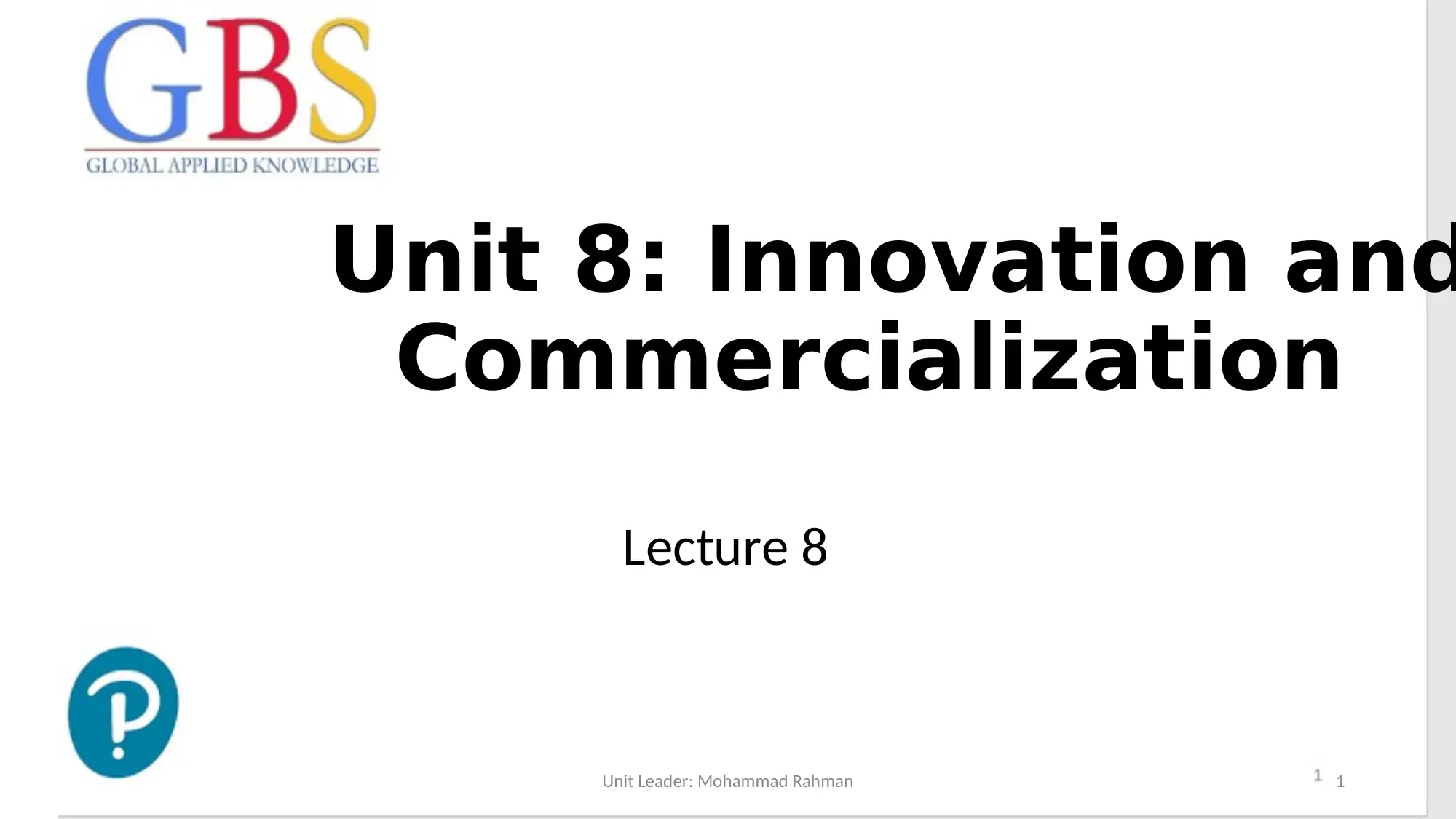
Unit 8: Innovation and
Commercialization
Lecture 8
Unit Leader: Mohammad Rahman 1
Commercialization
Lecture 8
Unit Leader: Mohammad Rahman 1
Secure Best Marks with AI Grader
Need help grading? Try our AI Grader for instant feedback on your assignments.

Business Model Canvas (BMC)
Unit Leader: Mr Syed 2
Unit Leader: Mr Syed 2
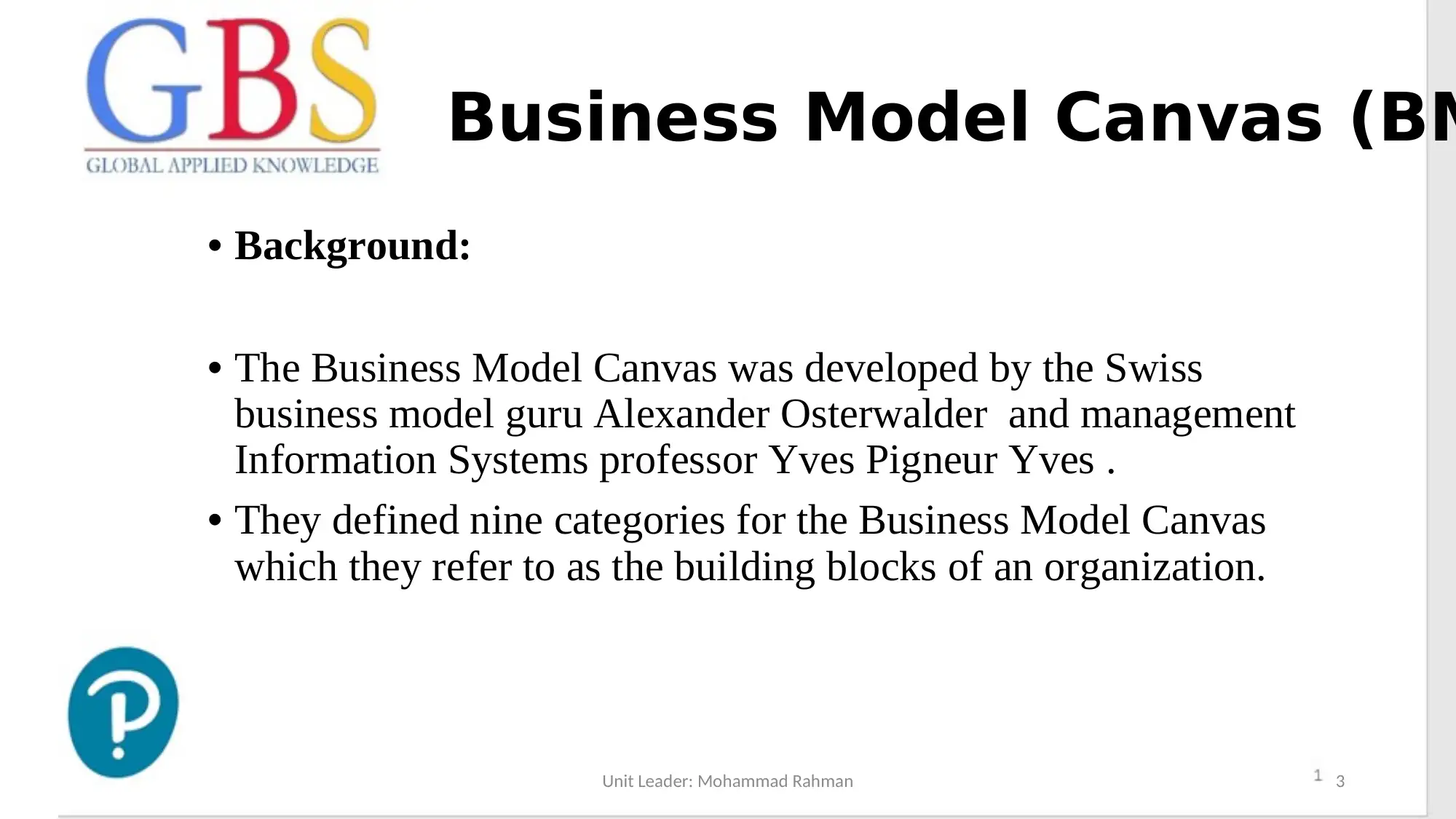
Business Model Canvas (BM
• Background:
• The Business Model Canvas was developed by the Swiss
business model guru Alexander Osterwalder and management
Information Systems professor Yves Pigneur Yves .
• They defined nine categories for the Business Model Canvas
which they refer to as the building blocks of an organization.
Unit Leader: Mohammad Rahman 3
• Background:
• The Business Model Canvas was developed by the Swiss
business model guru Alexander Osterwalder and management
Information Systems professor Yves Pigneur Yves .
• They defined nine categories for the Business Model Canvas
which they refer to as the building blocks of an organization.
Unit Leader: Mohammad Rahman 3

What is the Business Model C
The Business Model Canvas or BMC model is a graphic
representation of a number of variables that show the values of an
organization.
The Business Model Canvas can be deployed as a strategy tool for
The development of a new organization. Furthermore, it also
analyses the (business) situation of an existing business.
Unit Leader: Mohammad Rahman 4
The Business Model Canvas or BMC model is a graphic
representation of a number of variables that show the values of an
organization.
The Business Model Canvas can be deployed as a strategy tool for
The development of a new organization. Furthermore, it also
analyses the (business) situation of an existing business.
Unit Leader: Mohammad Rahman 4
Secure Best Marks with AI Grader
Need help grading? Try our AI Grader for instant feedback on your assignments.
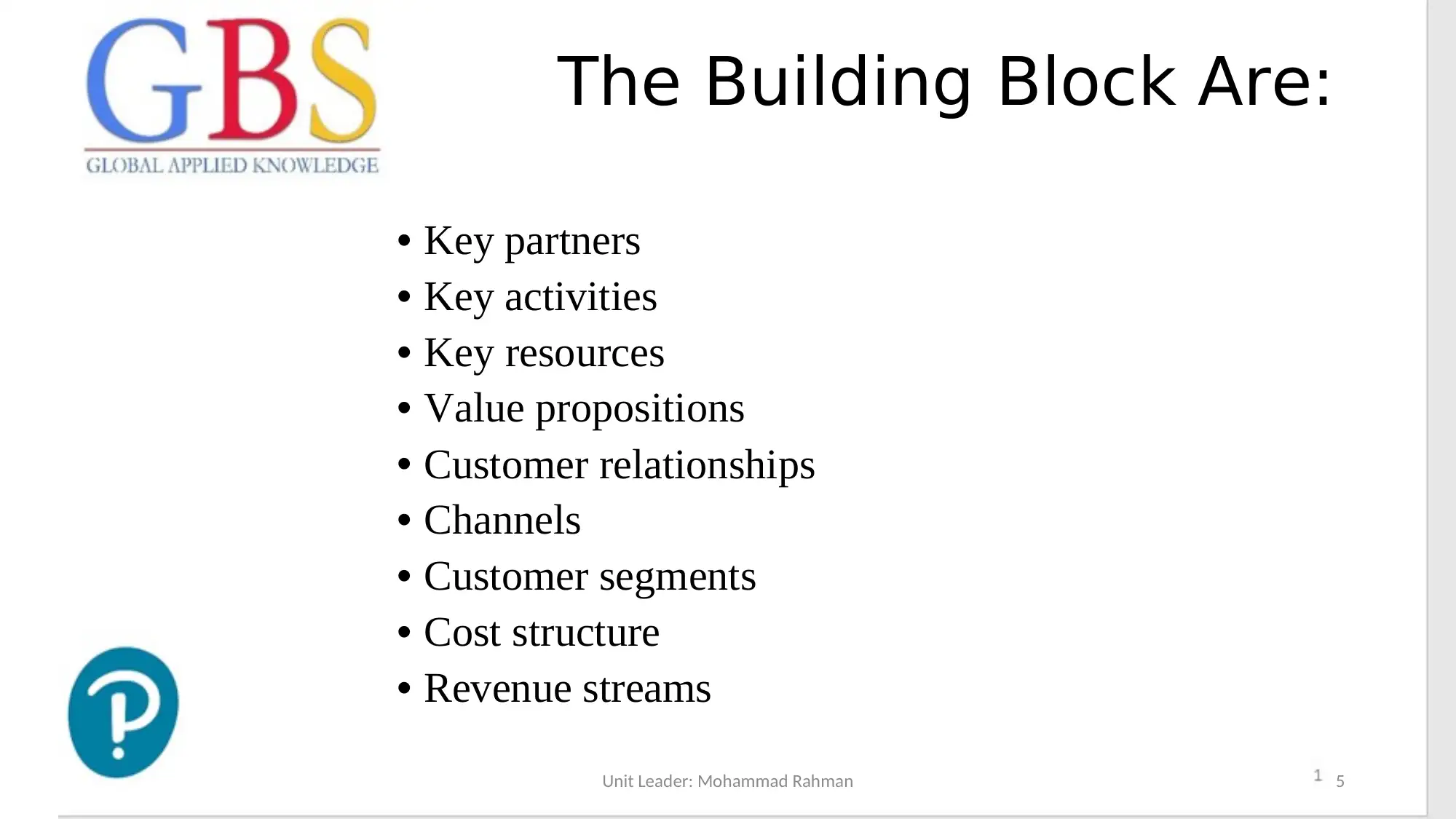
The Building Block Are:
• Key partners
• Key activities
• Key resources
• Value propositions
• Customer relationships
• Channels
• Customer segments
• Cost structure
• Revenue streams
Unit Leader: Mohammad Rahman 5
• Key partners
• Key activities
• Key resources
• Value propositions
• Customer relationships
• Channels
• Customer segments
• Cost structure
• Revenue streams
Unit Leader: Mohammad Rahman 5
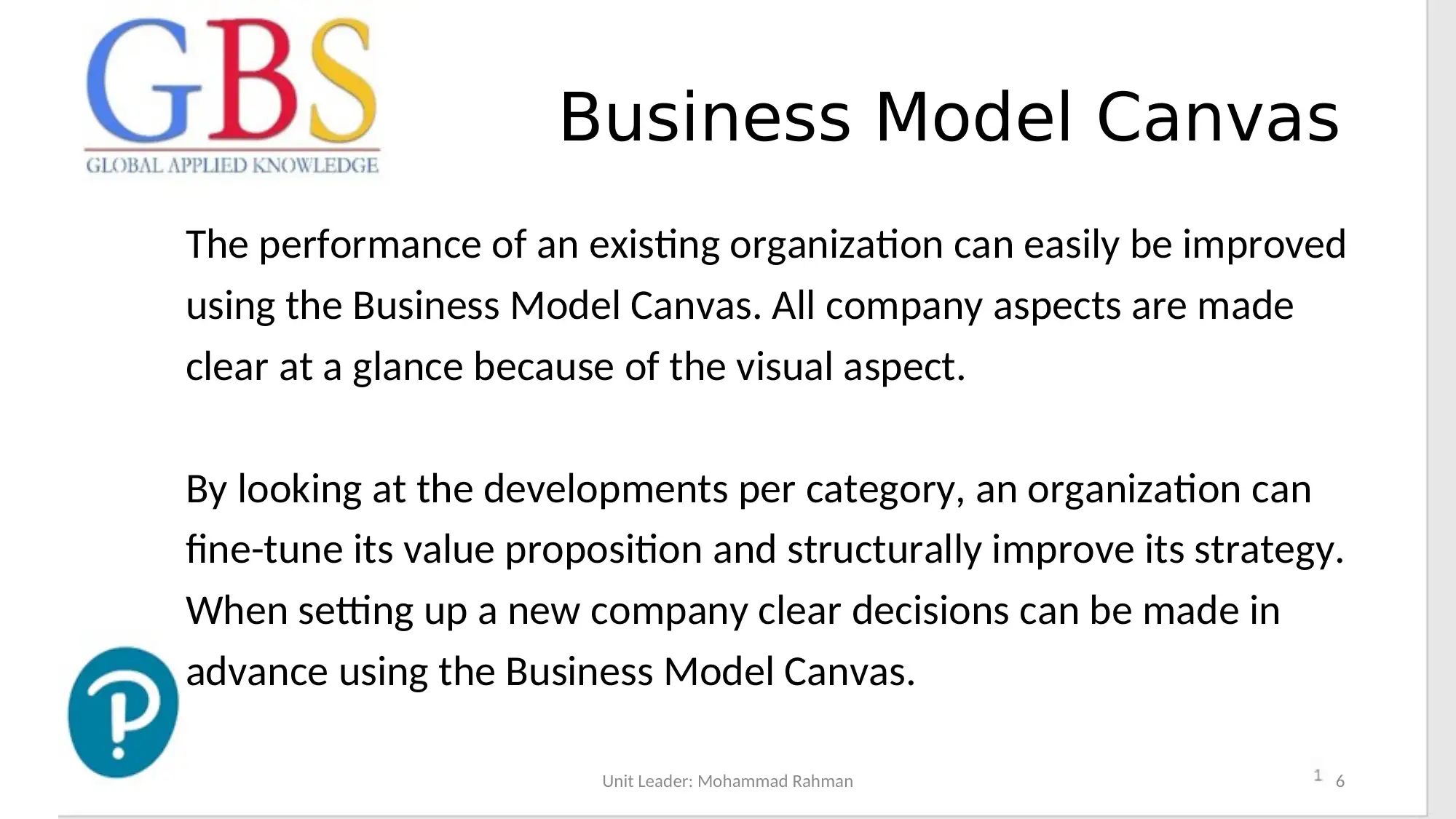
Business Model Canvas
The performance of an existing organization can easily be improved
using the Business Model Canvas. All company aspects are made
clear at a glance because of the visual aspect.
By looking at the developments per category, an organization can
fine-tune its value proposition and structurally improve its strategy.
When setting up a new company clear decisions can be made in
advance using the Business Model Canvas.
Unit Leader: Mohammad Rahman 6
The performance of an existing organization can easily be improved
using the Business Model Canvas. All company aspects are made
clear at a glance because of the visual aspect.
By looking at the developments per category, an organization can
fine-tune its value proposition and structurally improve its strategy.
When setting up a new company clear decisions can be made in
advance using the Business Model Canvas.
Unit Leader: Mohammad Rahman 6
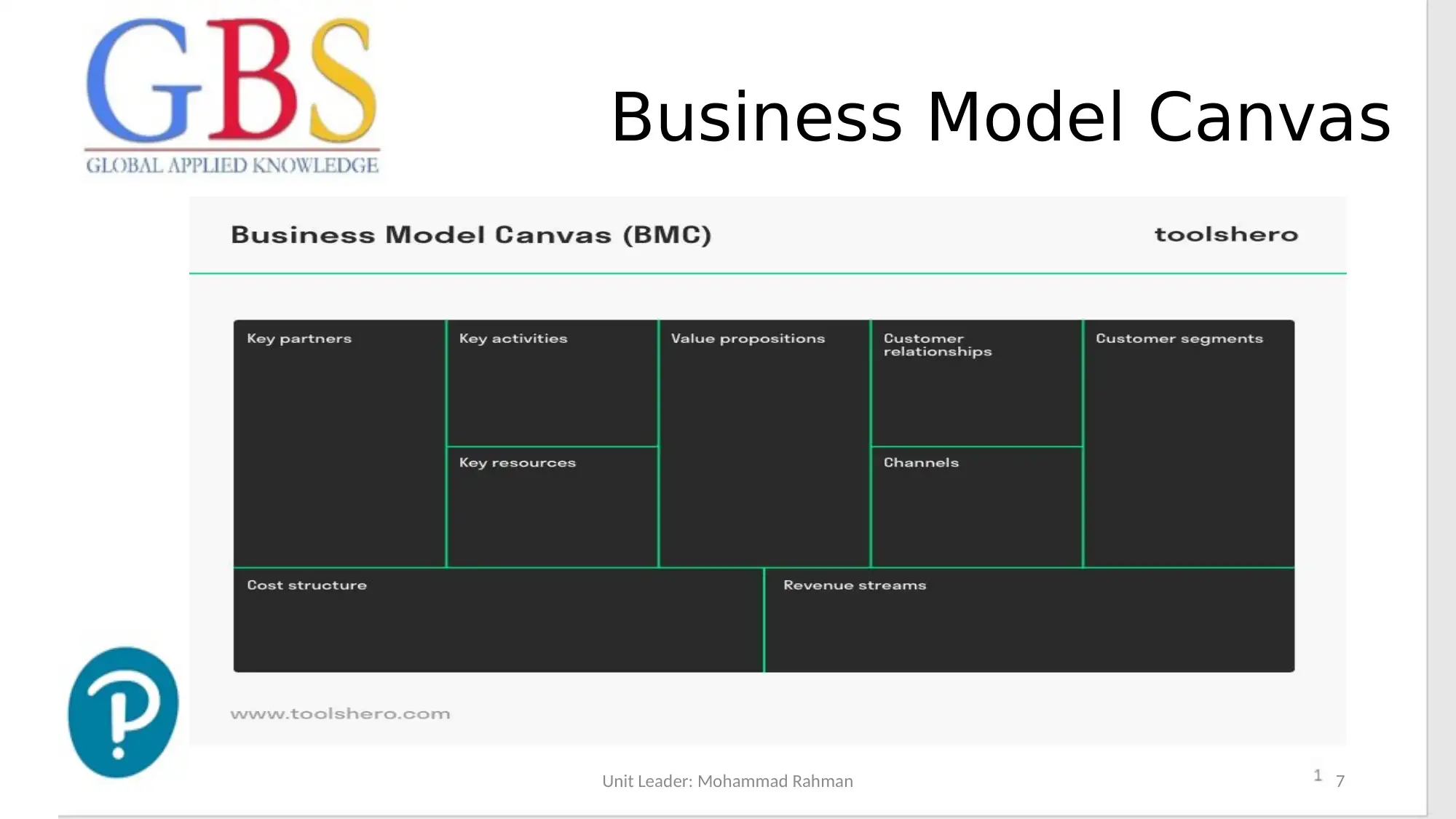
Business Model Canvas
Unit Leader: Mohammad Rahman 7
Unit Leader: Mohammad Rahman 7
Paraphrase This Document
Need a fresh take? Get an instant paraphrase of this document with our AI Paraphraser
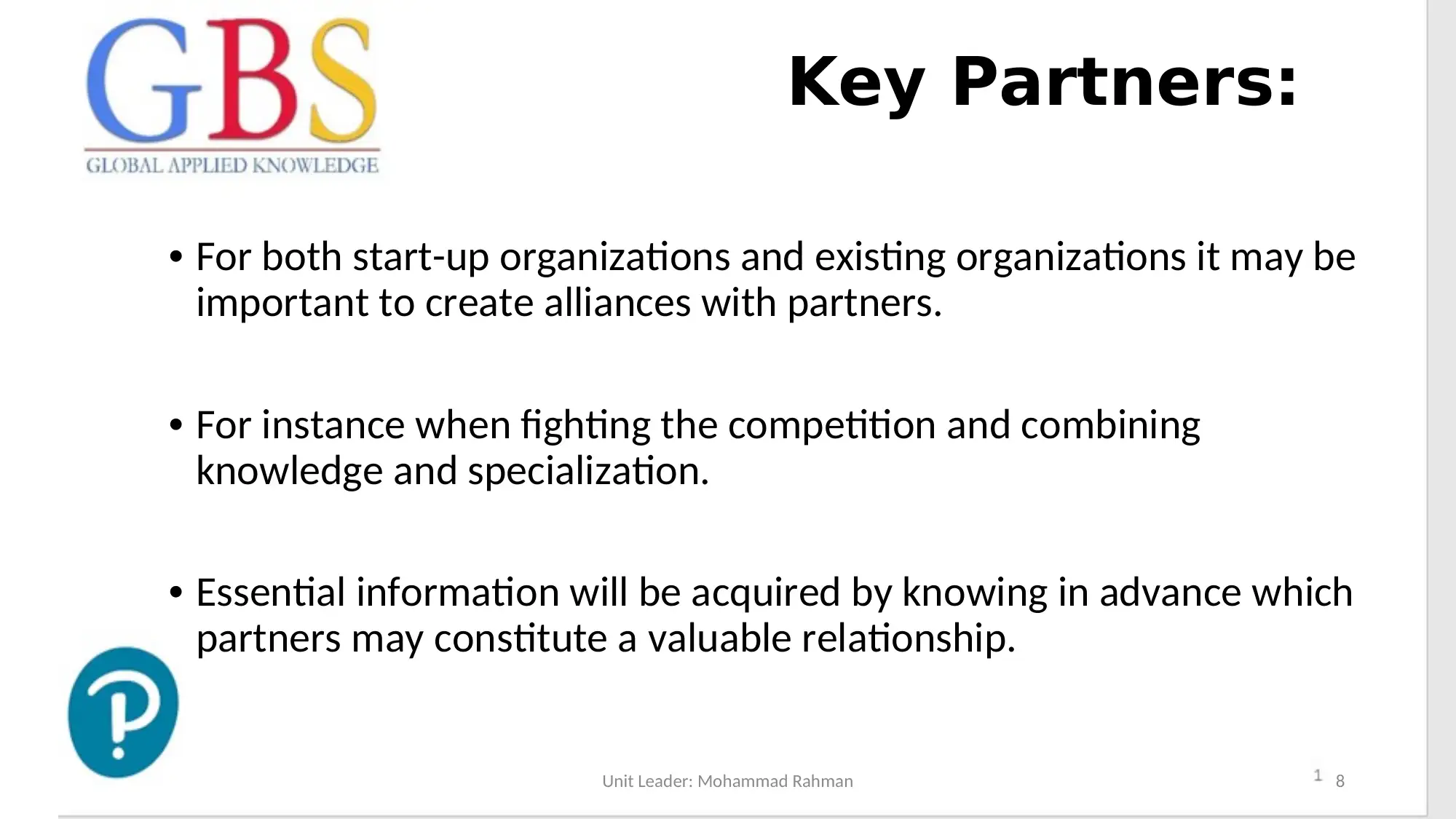
Key Partners:
• For both start-up organizations and existing organizations it may be
important to create alliances with partners.
• For instance when fighting the competition and combining
knowledge and specialization.
• Essential information will be acquired by knowing in advance which
partners may constitute a valuable relationship.
Unit Leader: Mohammad Rahman 8
• For both start-up organizations and existing organizations it may be
important to create alliances with partners.
• For instance when fighting the competition and combining
knowledge and specialization.
• Essential information will be acquired by knowing in advance which
partners may constitute a valuable relationship.
Unit Leader: Mohammad Rahman 8
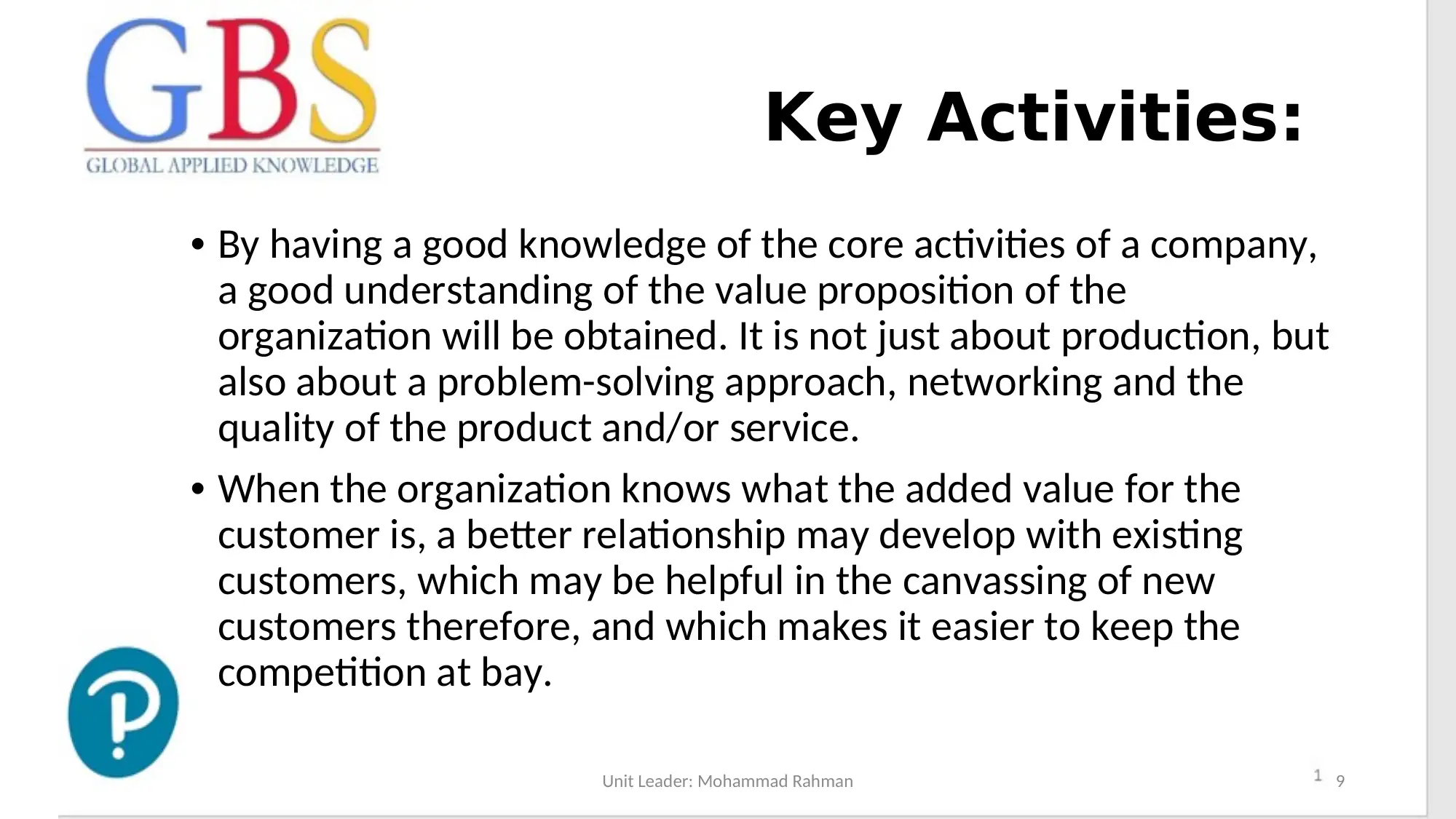
Key Activities:
• By having a good knowledge of the core activities of a company,
a good understanding of the value proposition of the
organization will be obtained. It is not just about production, but
also about a problem-solving approach, networking and the
quality of the product and/or service.
• When the organization knows what the added value for the
customer is, a better relationship may develop with existing
customers, which may be helpful in the canvassing of new
customers therefore, and which makes it easier to keep the
competition at bay.
Unit Leader: Mohammad Rahman 9
• By having a good knowledge of the core activities of a company,
a good understanding of the value proposition of the
organization will be obtained. It is not just about production, but
also about a problem-solving approach, networking and the
quality of the product and/or service.
• When the organization knows what the added value for the
customer is, a better relationship may develop with existing
customers, which may be helpful in the canvassing of new
customers therefore, and which makes it easier to keep the
competition at bay.
Unit Leader: Mohammad Rahman 9
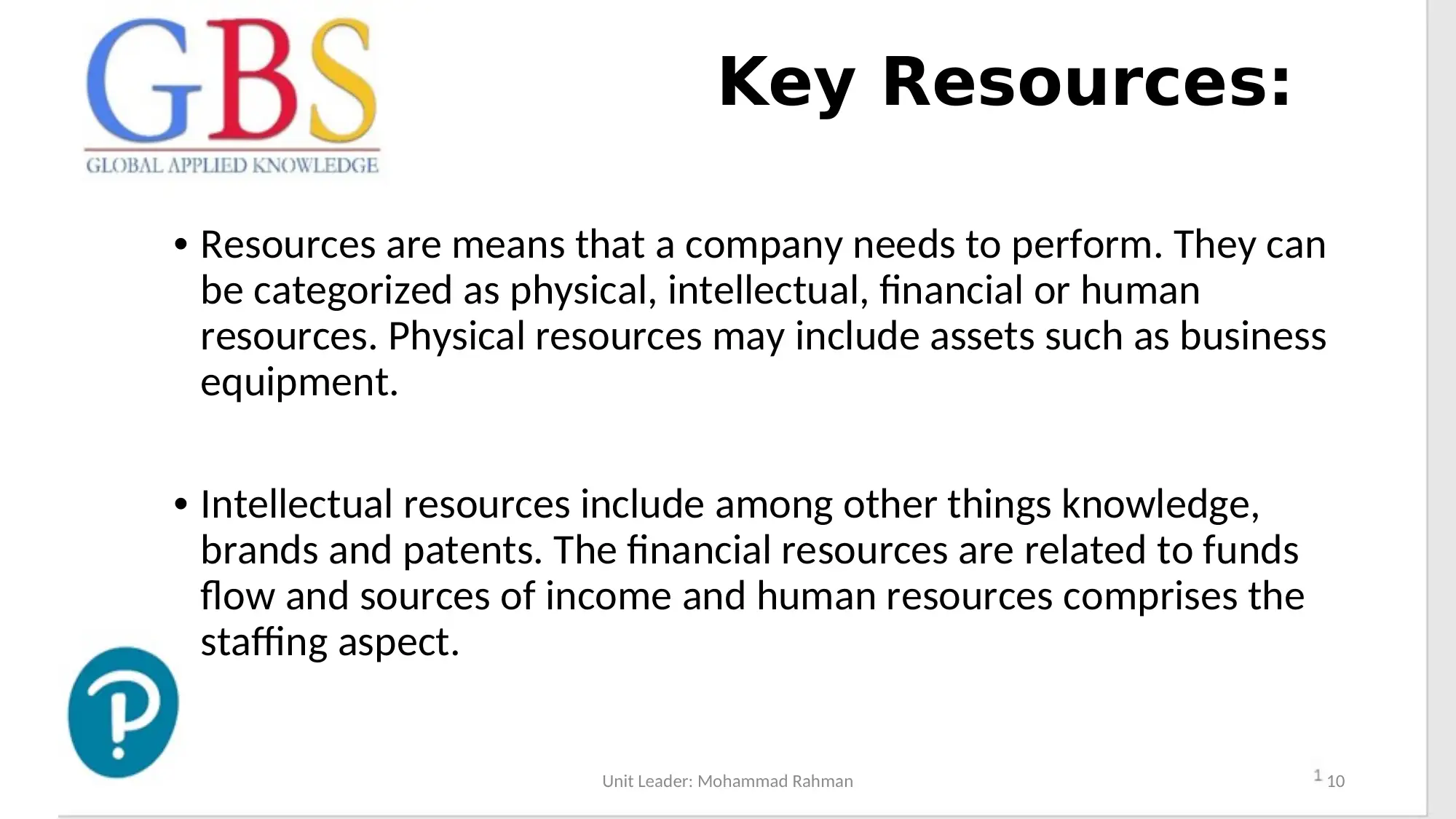
Key Resources:
• Resources are means that a company needs to perform. They can
be categorized as physical, intellectual, financial or human
resources. Physical resources may include assets such as business
equipment.
• Intellectual resources include among other things knowledge,
brands and patents. The financial resources are related to funds
flow and sources of income and human resources comprises the
staffing aspect.
Unit Leader: Mohammad Rahman 10
• Resources are means that a company needs to perform. They can
be categorized as physical, intellectual, financial or human
resources. Physical resources may include assets such as business
equipment.
• Intellectual resources include among other things knowledge,
brands and patents. The financial resources are related to funds
flow and sources of income and human resources comprises the
staffing aspect.
Unit Leader: Mohammad Rahman 10
Secure Best Marks with AI Grader
Need help grading? Try our AI Grader for instant feedback on your assignments.

Value Propositions:
• The value proposition is about the core of a company’s right to
exist, it meets the customer’s need.
• How does an organization distinguish itself from the
competition?
• This distinction focuses on quantity such as price, service, speed
and delivery conditions on the one hand, and on the other hand
it also focuses on quality including design, brand status and
customer experience and satisfaction.
Unit Leader: Mohammad Rahman 11
• The value proposition is about the core of a company’s right to
exist, it meets the customer’s need.
• How does an organization distinguish itself from the
competition?
• This distinction focuses on quantity such as price, service, speed
and delivery conditions on the one hand, and on the other hand
it also focuses on quality including design, brand status and
customer experience and satisfaction.
Unit Leader: Mohammad Rahman 11
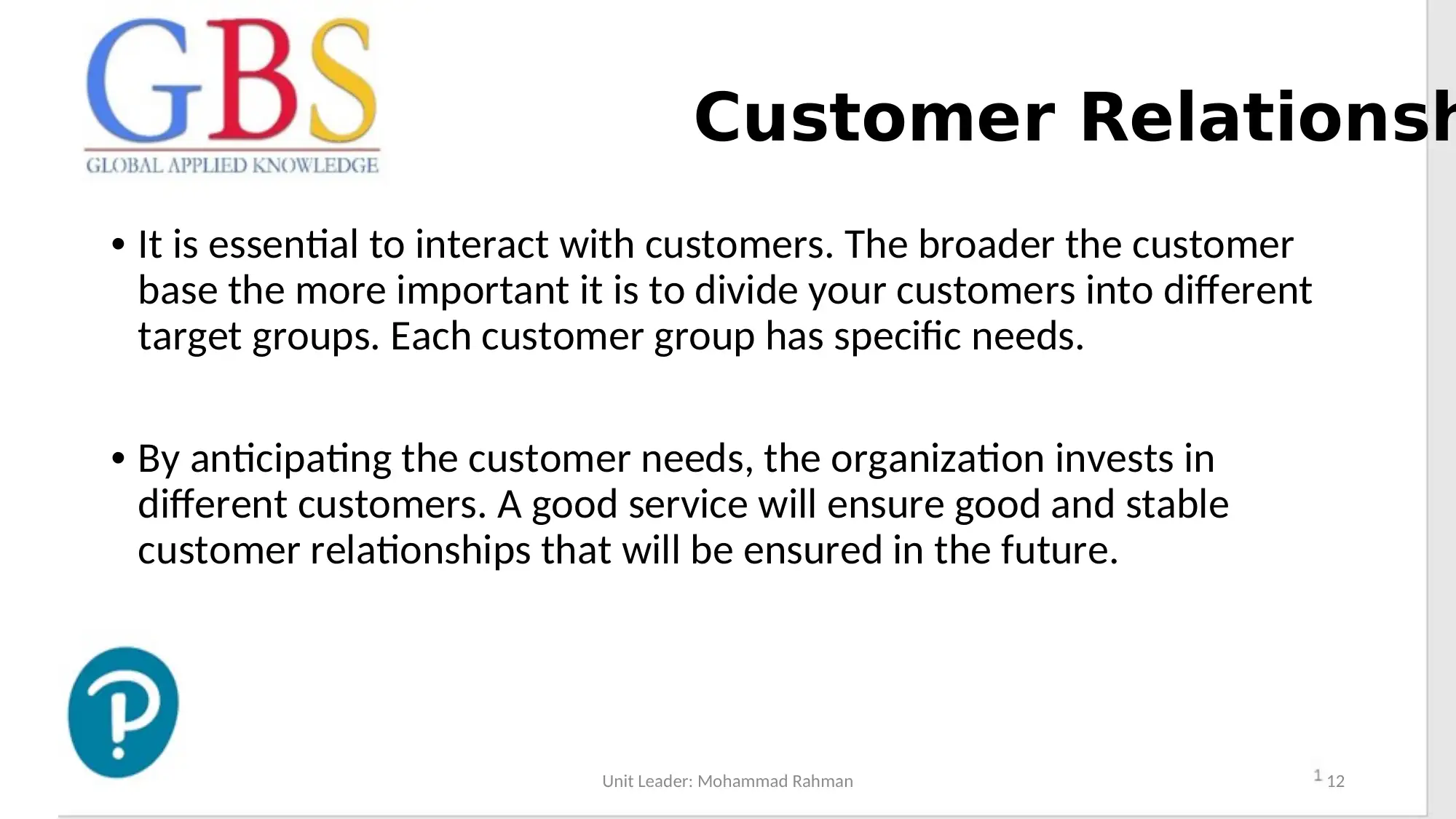
Customer Relationsh
• It is essential to interact with customers. The broader the customer
base the more important it is to divide your customers into different
target groups. Each customer group has specific needs.
• By anticipating the customer needs, the organization invests in
different customers. A good service will ensure good and stable
customer relationships that will be ensured in the future.
Unit Leader: Mohammad Rahman 12
• It is essential to interact with customers. The broader the customer
base the more important it is to divide your customers into different
target groups. Each customer group has specific needs.
• By anticipating the customer needs, the organization invests in
different customers. A good service will ensure good and stable
customer relationships that will be ensured in the future.
Unit Leader: Mohammad Rahman 12

Channels:
• An organization deals with communications, distribution and sales
channels. It is not just about customer contact and the way in
which an organization communicates with their customers. The
purchase location and the delivery of the product and/or services
provided are decisive elements in this.
• Channels to customers have five different stages: awareness of the
product, purchase, delivery, evaluation& satisfaction and after
sales. In order to make good use of the channels and to reach as
many customers as possible, it is advisable to combine off-line
(shops) and online (web shops) channels.
Unit Leader: Mohammad Rahman 13
• An organization deals with communications, distribution and sales
channels. It is not just about customer contact and the way in
which an organization communicates with their customers. The
purchase location and the delivery of the product and/or services
provided are decisive elements in this.
• Channels to customers have five different stages: awareness of the
product, purchase, delivery, evaluation& satisfaction and after
sales. In order to make good use of the channels and to reach as
many customers as possible, it is advisable to combine off-line
(shops) and online (web shops) channels.
Unit Leader: Mohammad Rahman 13
Paraphrase This Document
Need a fresh take? Get an instant paraphrase of this document with our AI Paraphraser
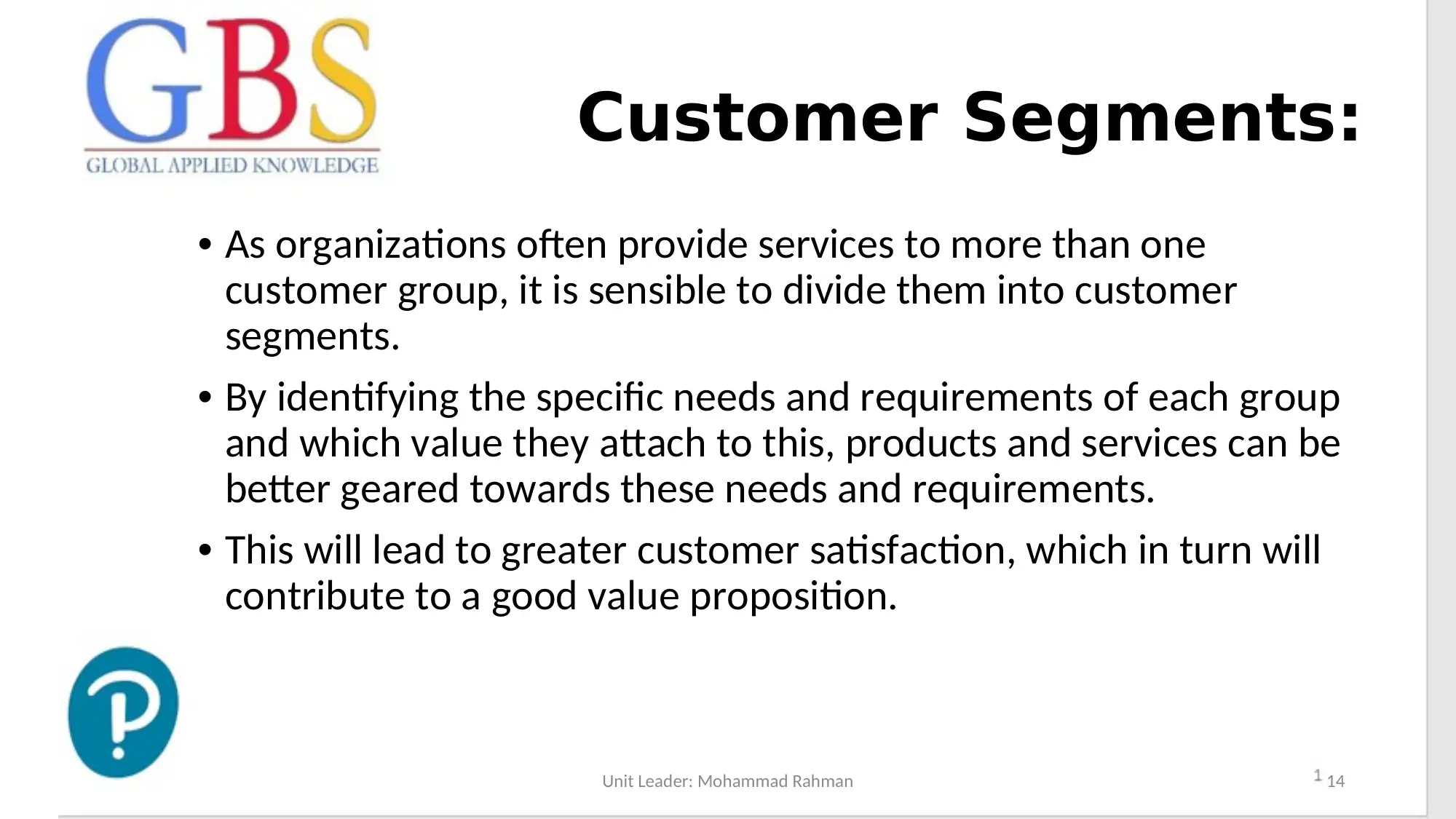
Customer Segments:
• As organizations often provide services to more than one
customer group, it is sensible to divide them into customer
segments.
• By identifying the specific needs and requirements of each group
and which value they attach to this, products and services can be
better geared towards these needs and requirements.
• This will lead to greater customer satisfaction, which in turn will
contribute to a good value proposition.
Unit Leader: Mohammad Rahman 14
• As organizations often provide services to more than one
customer group, it is sensible to divide them into customer
segments.
• By identifying the specific needs and requirements of each group
and which value they attach to this, products and services can be
better geared towards these needs and requirements.
• This will lead to greater customer satisfaction, which in turn will
contribute to a good value proposition.
Unit Leader: Mohammad Rahman 14
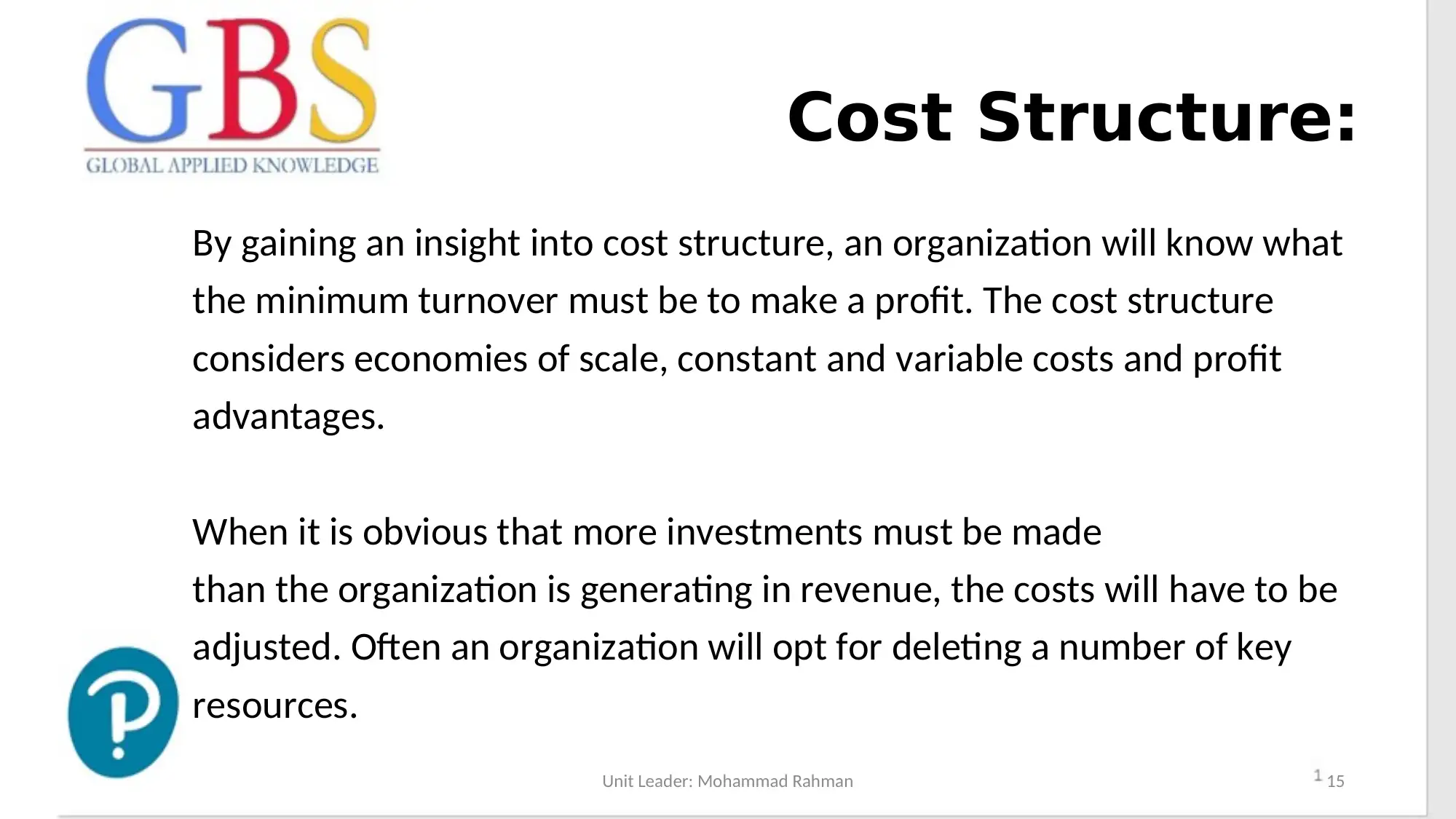
Cost Structure:
By gaining an insight into cost structure, an organization will know what
the minimum turnover must be to make a profit. The cost structure
considers economies of scale, constant and variable costs and profit
advantages.
When it is obvious that more investments must be made
than the organization is generating in revenue, the costs will have to be
adjusted. Often an organization will opt for deleting a number of key
resources.
Unit Leader: Mohammad Rahman 15
By gaining an insight into cost structure, an organization will know what
the minimum turnover must be to make a profit. The cost structure
considers economies of scale, constant and variable costs and profit
advantages.
When it is obvious that more investments must be made
than the organization is generating in revenue, the costs will have to be
adjusted. Often an organization will opt for deleting a number of key
resources.
Unit Leader: Mohammad Rahman 15

Revenue Streams:
• In addition to the cost structure, the revenue streams will provide
a clear insight into the revenue model of an organization.
• For example, how many customers does an organization need on
an annual basis to generate a profit? How much revenue does it
need to break even? The revenue streams are cost drivers.
• In addition to the revenue from the sale of goods, subscription
fees, lease income, licensing, sponsoring and advertising may also
be an option.
Unit Leader: Mohammad Rahman 16
• In addition to the cost structure, the revenue streams will provide
a clear insight into the revenue model of an organization.
• For example, how many customers does an organization need on
an annual basis to generate a profit? How much revenue does it
need to break even? The revenue streams are cost drivers.
• In addition to the revenue from the sale of goods, subscription
fees, lease income, licensing, sponsoring and advertising may also
be an option.
Unit Leader: Mohammad Rahman 16
Secure Best Marks with AI Grader
Need help grading? Try our AI Grader for instant feedback on your assignments.
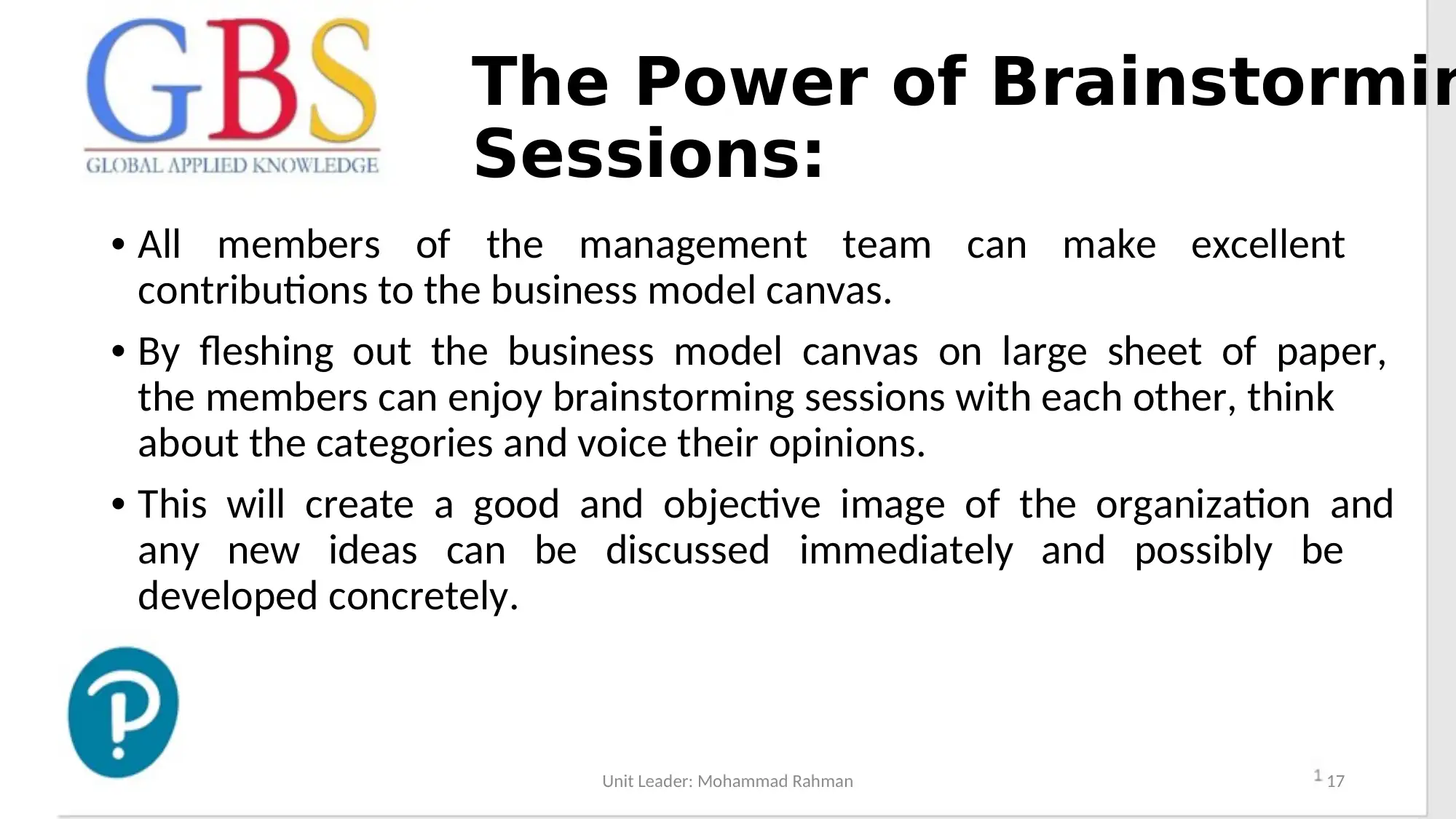
The Power of Brainstormin
Sessions:
• All members of the management team can make excellent
contributions to the business model canvas.
• By fleshing out the business model canvas on large sheet of paper,
the members can enjoy brainstorming sessions with each other, think
about the categories and voice their opinions.
• This will create a good and objective image of the organization and
any new ideas can be discussed immediately and possibly be
developed concretely.
Unit Leader: Mohammad Rahman 17
Sessions:
• All members of the management team can make excellent
contributions to the business model canvas.
• By fleshing out the business model canvas on large sheet of paper,
the members can enjoy brainstorming sessions with each other, think
about the categories and voice their opinions.
• This will create a good and objective image of the organization and
any new ideas can be discussed immediately and possibly be
developed concretely.
Unit Leader: Mohammad Rahman 17
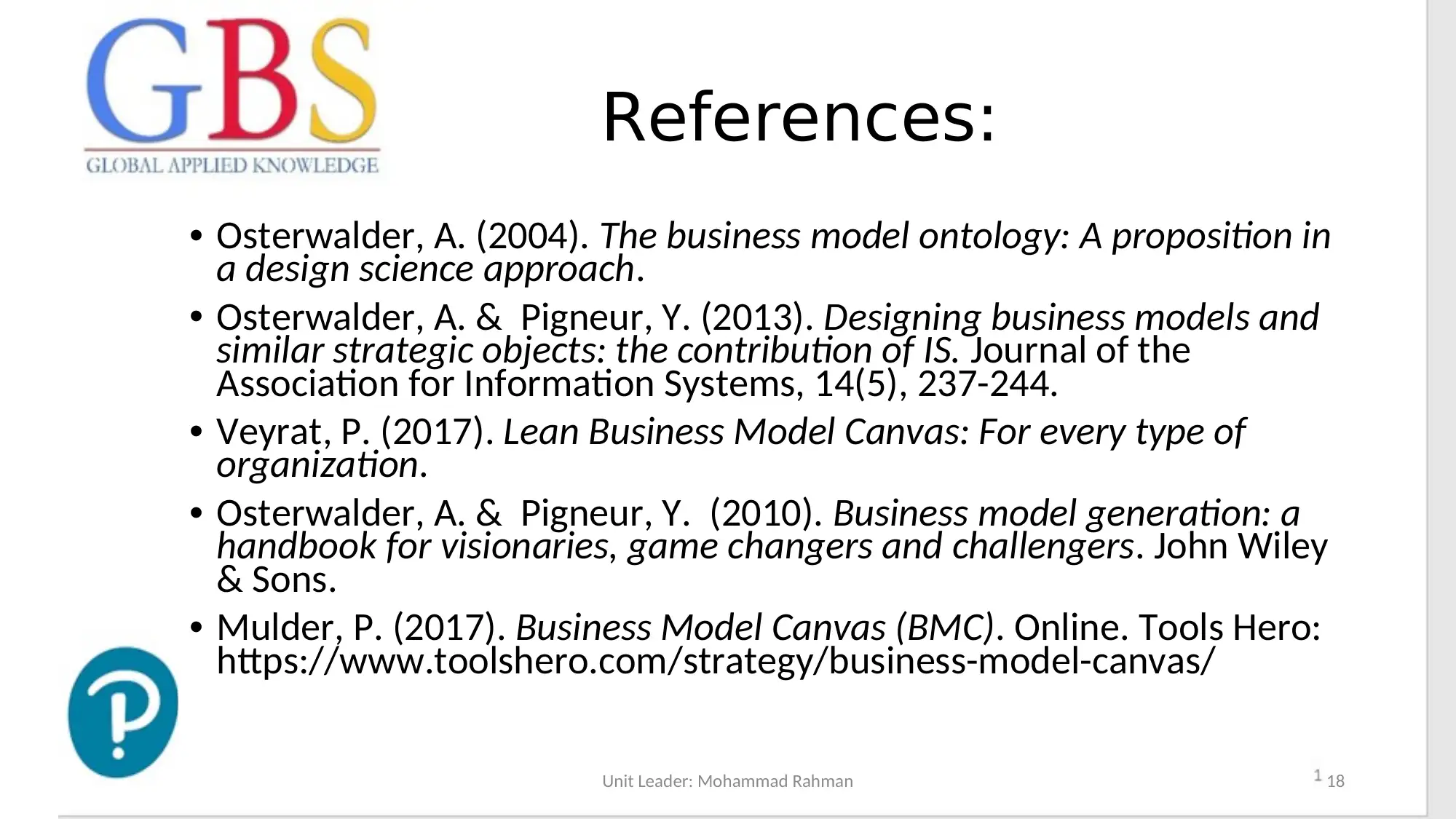
References:
• Osterwalder, A. (2004). The business model ontology: A proposition in
a design science approach.
• Osterwalder, A. & Pigneur, Y. (2013). Designing business models and
similar strategic objects: the contribution of IS. Journal of the
Association for Information Systems, 14(5), 237-244.
• Veyrat, P. (2017). Lean Business Model Canvas: For every type of
organization.
• Osterwalder, A. & Pigneur, Y. (2010). Business model generation: a
handbook for visionaries, game changers and challengers. John Wiley
& Sons.
• Mulder, P. (2017). Business Model Canvas (BMC). Online. Tools Hero:
https://www.toolshero.com/strategy/business-model-canvas/
Unit Leader: Mohammad Rahman 18
• Osterwalder, A. (2004). The business model ontology: A proposition in
a design science approach.
• Osterwalder, A. & Pigneur, Y. (2013). Designing business models and
similar strategic objects: the contribution of IS. Journal of the
Association for Information Systems, 14(5), 237-244.
• Veyrat, P. (2017). Lean Business Model Canvas: For every type of
organization.
• Osterwalder, A. & Pigneur, Y. (2010). Business model generation: a
handbook for visionaries, game changers and challengers. John Wiley
& Sons.
• Mulder, P. (2017). Business Model Canvas (BMC). Online. Tools Hero:
https://www.toolshero.com/strategy/business-model-canvas/
Unit Leader: Mohammad Rahman 18
1 out of 18
Related Documents
Your All-in-One AI-Powered Toolkit for Academic Success.
+13062052269
info@desklib.com
Available 24*7 on WhatsApp / Email
![[object Object]](/_next/static/media/star-bottom.7253800d.svg)
Unlock your academic potential
© 2024 | Zucol Services PVT LTD | All rights reserved.





